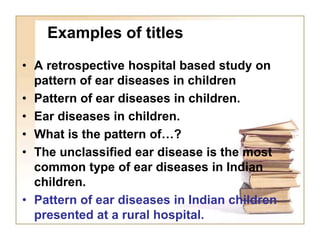51981.ppt
- 1. Article Review Nadeem Abbas Bukhari
- 2. Purpose of reviewing • Within the scope of the journal. • Detect methodological and presentational mistakes. • Confirm novelty. • Constructive criticism to improve the paper. • Confirm that the ethical issues are taken care of. • To assure that it would add to the citation of the journal. (IF)
- 3. Characters of a reviewer • Objectivity, • Fairness, • Speed, • Professionalism, • Confidentiality, • Honesty, • and courtesy. (Parberry, 1989)
- 4. Title • Informative – Reflect the content of the article. – Area of study. – Study design. e.g.(impact, effect, prev., association, correlation...etc. – Neither a question, nor a conclusion. • Concise – No repetition. – Not exceeding 15 words
- 5. Examples of titles • A retrospective hospital based study on pattern of ear diseases in children • Pattern of ear diseases in children. • Ear diseases in children. • What is the pattern of…? • The unclassified ear disease is the most common type of ear diseases in Indian children. • Pattern of ear diseases in Indian children presented at a rural hospital.
- 6. Abstract Structured • Max 250 words Not structured • 150 words • Introductory sentence indicates the importance. • Objective: (the general) • Method: study design – sample size – area- sampling technique - description of method. • Results: That achieve the objective. • Conclusion: An answer of the research question.
- 7. Context: The burden of ear problems are increasing in both developing and developed countries and it is one of the common medical problems in children and an important cause of hearing loss among them. Aim: The present study aims to find out the pattern of ear diseases among children below 15 years based on the variables such as age, sex and year. Study Design and Settings: It is a retrospective study of five years conducted in medical college hospital at the Ernakulam district of Kerala State, India. Methods and Materials: The data were collected from the Medical records department and analysed by using SPSS. Statistical analysis used: ‘Z’ test was applied for finding out the difference in proportions. Result: Out of 408 cases, 49.75% were females and 50.25% were males. Of the total cases, 30.4% were in 0-5 years, 40.7% were in 5- 9 years and 28.9% were in 10-14 years age groups. The most common type is other chronic suppurative otitis media (30.9%) and was followed by Acute suppurative otitis media 15.2%. In male and females the most common type of ear disease is other chronic suppurative otitis media and in males it is 28.3% and in females it is 17.1% respectively. Conclusion: Since ear problems an important cause of hearing loss in children, it is important to know its pattern and frequency and this would be helpful to strengthen preventive as well as early detection measures to reduce ear problems and thereby hearing loss among them. Key words: Ear diseases, age, sex and year.
- 8. INTRODUCTION • Adequacy of the rationale of the research: • The burden of the health problem: • Mortality. • Morbidity. • Economic burden. • Following the format of the publisher. • Awareness of related work. • Answers a valid research question. • Un biased review of the literature (peer competition, drop previous answers to his research question) . • Appropriate number of relevant references. • Logic development of the argument • The objective is stated in the last sentence.
- 9. Methodology • Mistakes in this section could be fatal. • Look at: – Study design. – Sample size (calculate according to the findings). – Sampling technique. – Case definition. – Techniques of evaluation. – Data management. – Repeatability.
- 10. Results • The significance of the results. • Appropriate presentation of findings. • The tables and figures are self explained. • 1 table : 1000 word. • The flow of the findings is logic • and online with the objectives.
- 11. Discussion • Discussion tell a story on their own. • Gaps are pointed to. • Ability to clarify the differences if any. • The conclusions follow from the work described? • The last sentence should be the ??????. (the conclusion)
- 12. References • Are the references and citations formatted properly? Vancouver or Harvard style. • Are the references "fully formed"? • Are they retrievable?
- 13. Overall Recommendation • Accept in its present form with no revisions • Accept after minor revisions (re-review unnecessary) • Accept after major revisions (after re- review) • Reject but encourage re-submission in another form (e.g. short paper, poster) • Reject
- 14. Before saying REJECT Assume that most work has been conducted by other hard working and honest people like ourselves who are proud of the work they have done. If you don't think the work is ready for publication, then explain why, and tell them how useful it will be when suitably improved; The main reason why papers are turned down is not because the work is defective, but because it's value has been badly communicated or it has been submitted to an inappropriate venue.
- 15. Further readings • Hugh Davis www.ecs.soton.ac.uk/~hcd • Dale J. Benos, Kevin L. Kirk and John E. Hall. How to Review a Paper. Advan. Physiol. Edu. 27: 47-52, 2003; http://advan.physiology.org/cgi/content/full/2 7/2/47 (Last accessed 16th Jan 2007) • Barak A. Pearlmutter. How to Review a Scientific Paper. http://www.cs.unm.edu/~bap/how-to- review.html (last accessed 16th Jan 2007)
- 16. Thank you
Editor's Notes
- #16: Hugh Davis www.ecs.soton.ac.uk/~hcd Dale J. Benos, Kevin L. Kirk and John E. Hall. How to Review a Paper. Advan. Physiol. Edu. 27: 47-52, 2003; http://advan.physiology.org/cgi/content/full/27/2/47 (Last accessed 16th Jan 2007) Barak A. Pearlmutter. How to Review a Scientific Paper. http://www.cs.unm.edu/~bap/how-to-review.html (last accessed 16th Jan 2007)















